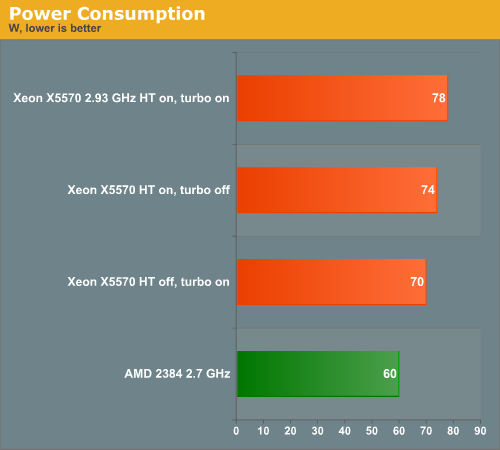The Best Server CPUs part 2: the Intel "Nehalem" Xeon X5570
by Johan De Gelas on March 30, 2009 3:00 PM EST- Posted in
- IT Computing
Power Consumption

The method we used does not allow us to determine the absolute idle power numbers very accurately, but it seems that Xeon X5570 consumes 8W to 10W less when running at idle. Again, all these numbers have a pretty high margin of error, but they are accurate enough to say that the Opteron 2384 consumes quite a bit less at full load while the latest Xeon is clearly the winner when you are running idle. If your application is running close to idle most of the time, with a few spikes at some parts of the day, the Xeon is the performance/watt champion.
The only question is what happens if the server is running most of the time at relatively high load (for example thanks to virtualization)? Then we have to remember that the CPU is only part of a complete server. Let us assume that the Nehalem server consumes 320W (which is close to what we measured). A similar AMD Opteron server can then save about 18W per CPU, and 1W per DIMM as high speed DDR3 is a bit more power hungry than DDR2 (which runs at a lower speed). We assume that we use six DIMMs per CPU.
| Power Comparison | |||
| Power consumption | Performance | Performance/Watt | |
| Intel X5570 2.93GHz | 320 | 116399 | 363.7469 |
| AMD | 270 | 70034 | 259.3852 |
We could say that the Nehalem is winning by a margin of about 40%. Now, it is clear that the absolute winner is difficult to determine; it all depends on your applications. Still, it is clear that when you compare the best Intel and AMD CPUs, the best performance/Watt figures come from Intel by pretty large margin.










44 Comments
View All Comments
usamaah - Monday, March 30, 2009 - link
Is it me or is page 2 of this article missing some information? The title of that 2nd page is "What Intel and AMD are Offering," but in the body of the text there are only descriptions of Intel's Xeon chips? Perhaps a new title to reflect the body, or add AMD info?JohanAnandtech - Monday, March 30, 2009 - link
I moved the AMD vs Intel pricing data to the back of the article as the pricing info is more interesting once you have seen the results. But forgot to change the title.. fixed. Thanks.usamaah - Monday, March 30, 2009 - link
Cool, thank you. Next time I'll finish reading the article before I make a comment, sorry ;-) Anyway wonderful article.Ipatinga - Monday, March 30, 2009 - link
Very nice to see a comparison over some generations of Xeon platform, including the new one (yet to be released).I would like to see a new article with Core i7 vs Xeon 5500... to check out if my Core i7 @ 3,7GHz is good enough in Maya 2009 (Windows XP 64bit, 12GB DDR3), or if a Xeon 5500 (each at 2,4GHz, for instance) in dual processor configuration will be a much better buy.